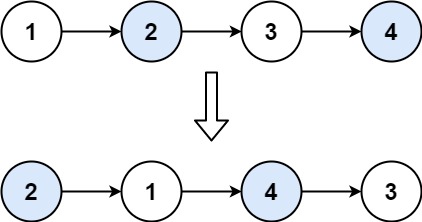# 两两交换链表相邻节点
前言: 两两交换这个模拟过程 我总是不知道 我是要定义 pre 和 cur 还是 cur 和 next 指针 可能两种方式都可以 但如果定义了虚拟头结点 dummy(我习惯写成 StartHead 了)那可能前者更好 因为 next 这个临时节点 可以在 while 里面(伴随判断定义)
# 题目 (中等)
给你一个链表,两两交换其中相邻的节点,并返回交换后链表的头节点。你必须在不修改节点内部的值的情况下完成本题(即,只能进行节点交换)。
示例 1:
img
2
输出:[2,1,4,3]示例 2:
2
输出:[]示例 3:
2
输出:[1]提示:
- 链表中节点的数目在范围
[0, 100]内0 <= Node.val <= 100
先看看我的垃圾错误解答吧。。
1 | public class Solution { |
修正过后
# 题解
1 | /** |
